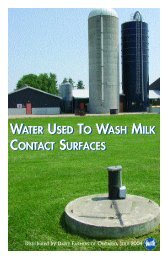Canadian Quality Milk On-Farm Food Safety Program - Centre ...
Canadian Quality Milk On-Farm Food Safety Program - Centre ...
Canadian Quality Milk On-Farm Food Safety Program - Centre ...
You also want an ePaper? Increase the reach of your titles
YUMPU automatically turns print PDFs into web optimized ePapers that Google loves.
<strong>Canadian</strong> <strong>Quality</strong> <strong>Milk</strong><br />
Introduction<br />
Sanitation is a basic Best Management Practice for any HACCP-based system.<br />
Equipment cleanliness is very important to keep bacteria counts as low as possible in<br />
raw milk. General sanitation of the milking environment is also important to help avoid<br />
the accidental introduction of bacteria through the processes of milking and milk<br />
storage. Poor equipment cleaning is another cause of high bacteria counts and potential<br />
chemical residues through the cleaning chemicals.<br />
While many dairy producers have highly automated systems today, producers still have<br />
to ensure that the equipment is functioning properly and is well maintained.<br />
7.1 EQUIPMENT SANITATION<br />
7.1.1 Cleaning the <strong>Milk</strong>ing Equipment According to the<br />
Cleaning and Sanitizing Chart<br />
A qualified technician or industry professional must establish an equipment washing<br />
procedure for your farm (refer to cleaning and sanitizing chart in the Workbook, Record<br />
14). This procedure must be posted in the milk house or located in an easily accessible<br />
place in the milk house. If system changes occur after the chart is filled out (e.g. new<br />
chemicals, new equipment), the chart must be up-dated immediately. The chart must<br />
include the name of the company, signature of the technician or industry professional<br />
who completed the report and the date it was completed.<br />
For each wash cycle, the cleaning and sanitizing chart should specify the:<br />
• Product name and volume of product. Products used on milk contact surfaces<br />
need to be approved for use in food establishments or recommended by the<br />
manufacturer to clean dairy equipment. The label must state one or the other to<br />
be considered approved.<br />
• Volume of water.<br />
• Wash water temperature (according to the label directions of the products used<br />
or equipment dealer recommendation).<br />
• Water analysis (e.g. pH).<br />
Table 13 outlines the recommended standard for milking equipment sanitation;<br />
however, each farm may be slightly different depending on what temperatures the<br />
products being used require.<br />
June 2010 7—3
















